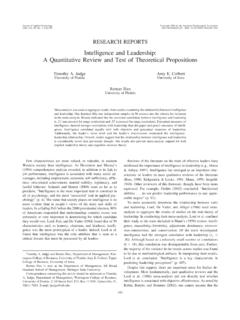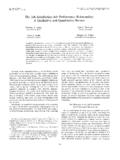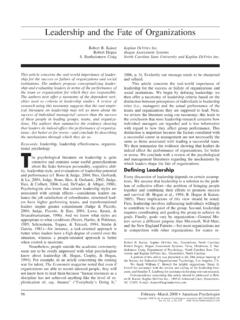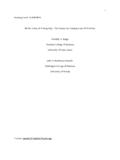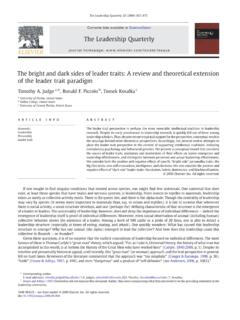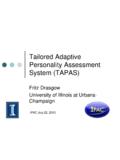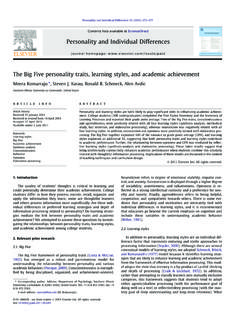Transcription of Hierarchical Representations of the Five-Factor Model of ...
1 Hierarchical Representations of the Five-Factor Model of Personality inPredicting Job Performance: Integrating Three Organizing FrameworksWith Two Theoretical PerspectivesTimothy A. JudgeUniversity of Notre Dame and University College LondonJessica B. RodellUniversity of GeorgiaRyan L. KlingerOld Dominion UniversityLauren S. SimonPortland State UniversityEean R. CrawfordUniversity of IowaIntegrating 2 theoretical perspectives on predictor criterion relationships, the present study developedand tested a Hierarchical framework in which each Five-Factor Model (FFM) personality trait comprises2 DeYoung, Quilty, and Peterson (2007)facets, which in turn comprise 6 Costa and McCrae (1992)NEOfacets. Both theoretical perspectives the bandwidth-fidelity dilemma and construct correspondence suggest that lower order traits would better predict facets of job performance (task performance andcontextual performance).
2 They differ, however, as to the relative merits of broad and narrow traits inpredicting a broad criterion (overall job performance). We first meta-analyzed the relationship of the 30 NEO facets to overall job performance and its facets. Overall, 1,176 correlations from 410 independentsamples (combinedN 406,029) were coded and meta-analyzed. We then formed the 10 DeYoung etal. facets from the NEO facets, and 5 broad traits from those facets. Overall, results provided support forthe 6 2 1 framework in general and the importance of the NEO facets in :personality, job performance, Five-Factor Model , big five , bandwidth-fidelityFew theoretical frameworks can compete with the impact of thefive-factor Model (FFM) on psychological science a GoogleScholar search turns up more than 18,000 citations to the FFM orBig five .
3 This impact does not mean, however, that we know allthere is to know about the framework. One unresolved issueconcerns the Hierarchical structure of the FFM traits. WhileCostaand McCrae s (1992)NEO framework where each of the FFMtraits has six facets remains the most popular, criticisms havebeen leveled against this Model (Roberts, Walton, & Viechtbauer,2006). More recently,DeYoung, Quilty, and Peterson (2007)sought to address this issue by integrating prior trait frameworksinto a 10-facet structure (two for each broad FFM trait). Otherframeworks also exist, albeit with less empirical support than theCosta and McCrae Hierarchical structure and with weaker theoret-ical grounding than the DeYoung et al. the foregoing debate regarding the nature of the lowerorder traits is important, this literature leaves unaddressed a centraltheoretical and practical question: How important are these lowerorder traits?
4 Even if we confine our analyses to perhaps the mostsalient application of the FFM in organizational psychology theBig five predictors of job performance the answer to this ques-tion is not clear. While some argue that the broad big five traitsare ideally suited to predict broad criteria such as job performance(Barrick & Mount, 2005;Ones & Viswesvaran, 1996;Stewart,2008), others contend that the big five are too broad (Paunonen,Rothstein, & Jackson, 1999;Schneider, Hough, & Dunnette, 1996;Tett, Steele, & Beauregard, 2003) or that other, more finelygrained traits may be relevant (Tett & Christiansen, 2007).Houghand Oswald (2005), for example, argued that the FFM is often toobroad for understanding and predicting work-related criteria ( ).
5 Given the importance of this question and the presence ofmore than 10 meta-analyses investigating the relationship betweenthe broad FFM traits and job performance it is somewhat sur-prising that the debate persists. To be sure, with respect to con-scientiousness, there have been some important efforts to addressthis question, both with primary studies (Stewart, 1999) and meta-analytically (Dudley, Orvis, Lebiecki, & Cortina, 2006). We areaware of no previous research, however, that provides a compre-This article was published Online First September 9, A. Judge, Mendoza College of Business, University of NotreDame, and Faculty of Brain Sciences, Division of Psychology & LanguageSciences, University College London, London, England; Jessica B.
6 Rodell,Terry College of Business, University of Georgia; Ryan L. Klinger, Col-lege of Business and Public Administration, Old Dominion University;Lauren S. Simon, School of Business Administration, Portland State Uni-versity; Eean R. Crawford, Tippie College of Business, University of concerning this article should be addressed to TimothyA. Judge, Mendoza College of Business, 360 MCOB, University of NotreDame, Notre Dame, IN 46556. document is copyrighted by the American Psychological Association or one of its allied article is intended solely for the personal use of the individual user and is not to be disseminated of Applied Psychology 2013 American Psychological Association2013, Vol. 98, No. 6, 875 9250021-9010/13/$ test with an accepted framework of the entire recognizedset of lower order FFM facets.
7 This is important because some ofthe weaker overall relationships of the other big five traits withperformance may be masking significant relationships at the facetlevel, especially when varying correlations of performance withthe trait s facets exist (Hough & Furnham, 2003;Paunonen &Ashton, 2001;Stewart, 1999).Accordingly, the purpose of the present study is to provide ananalysis of the degree to which broad and faceted representationsof the big five traits contribute to the prediction of job perfor-mance. In developing hypotheses about these relationships, wesought to integrate two theoretical statements of predictor criterion relationships: the bandwidth-fidelity dilemma and con-struct correspondence. Following the general advice ofRoberts etal.
8 (2006, p. 29) that future meta-analyses should organize dataaccording to a replicable lower order structure of personalitytraits, we utilize a recently developed and increasingly used lowerorder trait taxonomy (DeYoung et al., 2007) and relate the BigFive and this lower order taxonomy to job performance. Given thatCosta and McCrae s (1992)NEO framework has played such aprominent role in personality research to date, we also relate thislower order taxonomy to job performance. In addition to consid-ering the broad criterion of overall job performance, we take intoaccount two lower order facets of performance: task performanceand contextual performance. In the next section, we review thelower order trait taxonomy proposed byDeYoung et al.
9 (2007),discuss issues of correspondence between traits and criteria, andthen propose a 6 2 1 Hierarchical framework to guide hypothe-sized relations of broad and narrow traits to the and HypothesesHierarchical Representations of theFive-Factor ModelThere is little dispute that the big five represent broad traits orfactors composed of more specific facets or indicators. AsOnes,Viswesvaran, and Dilchert (2005, p. 391) commented,Data from multiple personality inventories and thousands of testtakers have provided consistent evidence for the Hierarchical organi-zation of personality. At the lowest level are individual responses totest items. Items that cluster together are indicators of specific attri-butes that may be referred to as personality subdimensions or that share psychological meaning, and most likely similaretiology, combine to define personality is disputed is the composition of those facets or lower ordertraits.
10 AsCosta and McCrae (1998, p. 117) noted, There is littleagreement on an optimal set of [lower order] traits. Costa andMcCrae (1992)posited six lower order traits for each of the fivefactors the definitions of which we provide inTable 1. Thisconceptualization has proven influential and et al. (2006)argued that theCosta and McCrae (1992)typol-ogy was measurement driven, so that the facets were producedfrom typical personality inventory construction methods (Rob-erts et al., 2006, p. 29). ThoughCosta and McCrae (1998)de-fended the reasonableness of their lower order taxonomy, theyacknowledged that identifying the optimal set of facets .. hasproven to be a difficult task (p. 118) and that the choice ofspecific facets appears to be somewhat arbitrary (p.)


